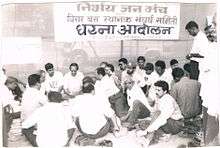Dharna
- For the village in Nepal see Dharna, Nepal

A dharna (Hindi: धरना, Nepali:धर्ना; Urdu: دهرنا), is a non-violent sit-in protest, which may include fast undertaken at the door of an offender, especially a debtor, in India as a means of obtaining compliance with a demand for justice, state response of criminal cases,[1] or payment of a debt. It was a popular form of protest during the Indian independence movement and part of Mahatma Gandhi's satyagraha form of civil disobedience and protest.[2][3]
In India, there are designated places for conducting Dharna, and a permission is required for it. Often, those practicing dharna break the permission leading to clashes with law enforcement.
Dharna generally refers to fixing one's mind on an object. It refers to whole-heartedly pledging toward an outcome or to inculcating a directed attitude. Dharna is consciously and diligently holding a point of view with the intent of achieving a goal.
The word originates from the Sanskrit word dharnam.
The word was first used in English in 1793 in a news item in the newspaper The Statesman about satyagrahis in Patna.[4]
Dharna was also used in Pakistan by Qazi Hussain Ahmed and Jammat e Islami Pakistan in 1993.
See also
References
- ↑ "Family members hold dharna under tree where girls were hanged". The Indian Express. June 9, 2014. Retrieved 2014-06-10.
- ↑ Rediscovering Gandhi. Concept Publishing Company. 2008. pp. 38–. ISBN 978-81-8069-480-6.
- ↑ Ramachandra Guha (2013). Gandhi Before India. Penguin Books Limited. pp. 1–. ISBN 978-93-5118-322-8.
- ↑ Qaiser Zoha Alam (1 January 1998). English Language Teaching In IndiaProblems And Issues. Atlantic Publishers & Dist. pp. 118–. ISBN 978-81-7156-554-2.